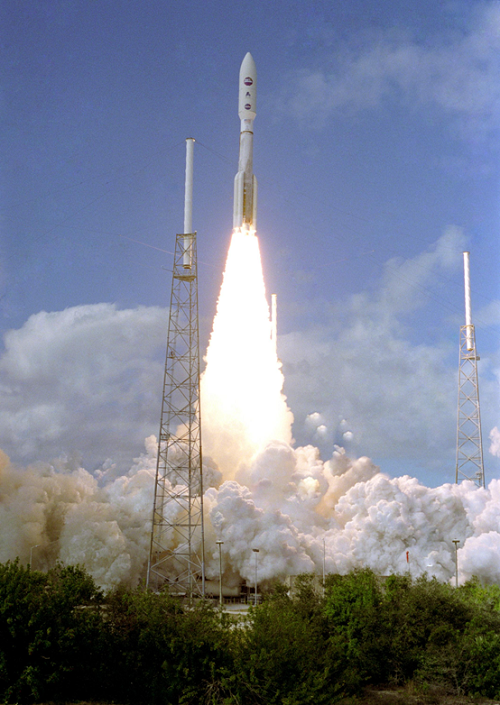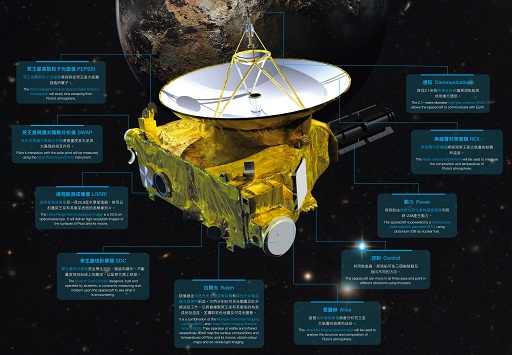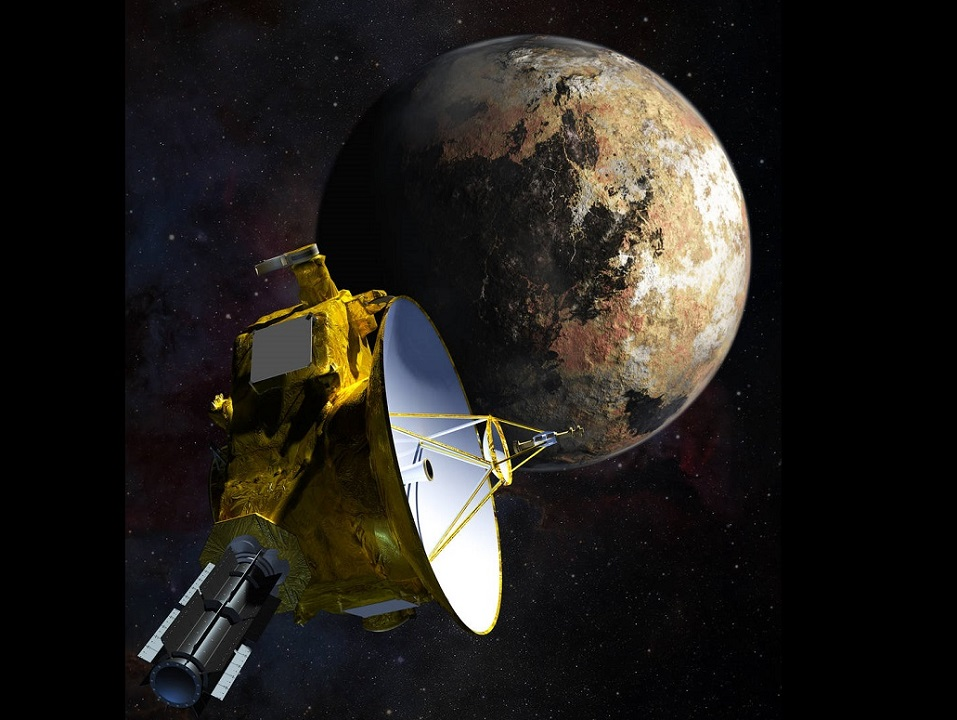
After a journey of more than nine years, the New Horizons spacecraft made its closest approach to flyby Pluto on 14 July 2015. It sent us the first close-up view of the dwarf planet and its five moons in the Kuiper Belt.

Originally, NASA had considered sending the Voyage 1 spacecraft on a flyby of Pluto in the late eighties. However, the mission was deemed too high a risk and Saturn's moon Titan was deemed a more realistic and interesting target. Therefore, the decision was made to not exercise the Pluto option.
This only served to motivate Dr Alan Stern and a handful of other young planetary scientists in 1989 to successfully appeal to NASA to begin studying the possibility of a mission to Pluto, what would be known as the "Pluto-350". The mission proposal began, however, amid budget cuts at NASA and the mission was deemed too costly.
NASA considered smaller missions with fewer instruments, non-nuclear missions with extended travel times for replacement. Then, in 2001, intense scientific and public pressure eventually convinced NASA to accept mission proposals for Pluto and Kuiper belt flyby missions, known as the "Pluto-Kuiper Belt Announcement of Opportunity".
Five proposals in total were handed to NASA in April 2001, one of which was the New Horizons proposal headed by Dr Stern through the Applied Physics Laboratory. In June 2001 it was selected, along with the competing Jet Propulsion Laboratory's Pluto and Outer Solar System Explorer concept, for US$450,000 of further study.
NASA finally informed Dr Stern that New Horizons had been selected as the mission that would go to Pluto on 29 November 2001. As the Applied Physics Laboratory and the Southwest Research Institute, both of which would develop and lead the mission, were not experienced in planetary missions, it was necessary to reduce the amount of risk in the spacecraft. So cost and schedule became of paramount importance. In total 2,500 individuals worked on the New Horizons mission throughout its development. At the third countdown attempt, on 19 January 2006, the spacecraft took flight aboard an Atlas V rocket, nine years after Pluto's discoverer Clyde Tombaugh had passed away.
New Horizons is a relatively small spacecraft weighing 481 kilograms. Its most striking feature is the 2.1-metre dish antenna for radio contact with the Earth. Beneath the dish is a triangular body containing seven scientific instruments. The instruments weigh less than 30 kilograms and use only 30 watts of energy. There are no solar panels, as at distances of billions of kilometres from the Sun, solar energy is not an option. The energy is derived from a thermoelectric generator which utilizes the radioactive decay of plutonium-238.
Pluto, is thought to have a nitrogen atmosphere and complex seasons. On its surface, it seems to have distinct surface markings, and it may have ice as well. New Horizons flew through Pluto's atmosphere, measured the interaction of the atmosphere with the solar wind, and took detailed pictures of the surface of Pluto and its moons. The probe also analysed Pluto's ultra-thin atmosphere.
The International Astronomical Union (IAU) voted to reclassify Pluto as a dwarf planet in 2006, and declared that Pluto was not a planet because it did not clear the neighbourhood around its orbit.
Pluto was once seen as a misfit in the solar system, but astronomers have found more objects like it in recent years. As at mid-2015, the IAU has designated four other worlds as dwarf planets: Eris, Makemake and Haumea, which are beyond Pluto's orbit, plus Ceres in the asteroid belt.
New Horizons was the first unmanned probe to visit Pluto. It has uncovered Pluto's secrets. What does its surface look like? Does it have mountains, cliffs, impact craters? What is the chemical composition of its frozen ground? Or of its thin atmosphere? And how is the atmosphere affected by electrically charged particles in the solar wind?

Launch 19 January 2006
New Horizons was launched on an Atlas V rocket and became the fastest spacecraft ever to leave the Earth orbit. It passed the Moon in just nine hours.
Mars 7 April 2006
The spacecraft crossed the orbit of Mars.
Jupiter 28 February 2007
The spacecraft passed Jupiter and used the giant planet as a gravity assist to get to Pluto at a speed of more than 20 kilometres a second.
Saturn 8 June 2008
The spacecraft crossed the orbit of Saturn.
Uranus 18 March 2011
The spacecraft crossed the orbit of Uranus.
Neptune 25 August 2014
After New Horizons passed the orbit of Neptune, it was awoken from hibernation on 6 December 2014.
Pluto 14 July 2015
New Horizons made its closest flyby to Pluto at 19:49:59 Hong Kong time. Owing to the high speed of New Horizons, the observation of Pluto will last just two hours.
Kuiper Belt Object 2017 and beyond
New Horizons visited Kuiper Belt objects.

PEPSSI
The Pluto Energetic Particle Spectrometer Science Investigation will study ions escaping from Pluto's atmosphere.
SWAP
Pluto's interaction with the solar wind will be measured using the Solar Wind Around Pluto instrument.
LORRI
The LOng Range Reconnaissance Imager is an 8.2-inch optical telescope. It will deliver high-resolution images of the surfaces of Pluto and its moons.
SDC
The Student Dust Counter, run by students, is constantly measuring dust incident upon the spacecraft to see what it is encountering.
Ralph
It is a combination of the Multispectral Visible Imaging Camera (MVIC) and Linear Etalon Imaging Spectral Array (LEISA). They operates at visible and infrared respectively. It will map the surface compositions and temperatures of Pluto and its moons, obtain colour maps and do visible-light imaging.
Alice
This ultraviolet imaging spectrometer will be used to analyse the structure and composition of Pluto's atmosphere.
REX
The Radio science EXperiment will be used to measure the composition and temperature of Pluto's atmosphere.
Communications
The 2.1-metre diameter high gain antenna (HGA) allows the spacecraft to communicate with Earth.
Control
The spacecraft can move in all three axis and point in different directions.
Power
The spacecraft is plutonium-238 powered by a radioisotope thermoelectric generator (RTG).
- Map the surface composition of Pluto and Charon
- Map the surface temperatures of Pluto and Charon
- Map the of Pluto and Charon
- Characterize the geology and morphology of Pluto and Charon
- Characterize the neutral atmosphere of Pluto and its escape rate
- Search for rings and additional satellites around Pluto
- Search for an atmosphere around Charon
- Conduct similar investigations on one or more Kuiper Belt Objects
A flag of the United States and a flag of the State of Florida
A small fragment of carbon-fibre material from SpaceShipOne
Some of the ashes of Clyde Tombaugh
A CD-ROM with 430,000 names collected from throughout the world

(Image credit: NASA/JHUAPL/SRI)

(Image credit: NASA/JHUAPL/SRI)

(Image credit: NASA/JHUAPL/SRI)

(Image credit: NASA/JHUAPL/SRI)

(Image credit: NASA/JHUAPL/SRI)

(Image credit: NASA/JHUAPL/SRI)

(Image credit: NASA/JHUAPL/SRI)

(Image credit: NASA/JHUAPL/SRI)


